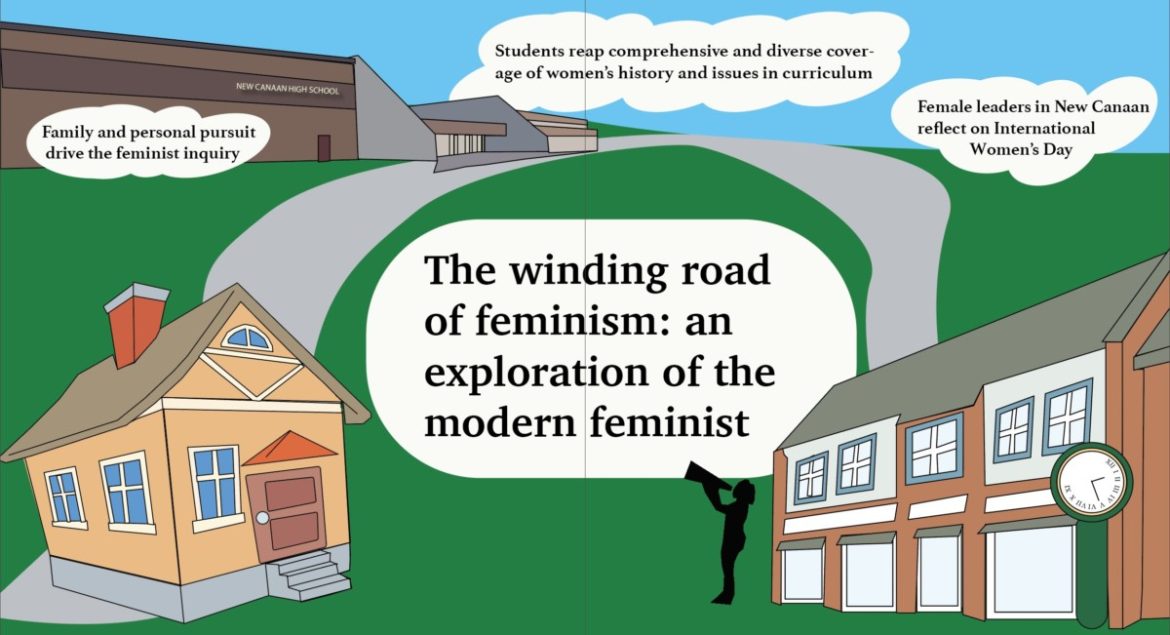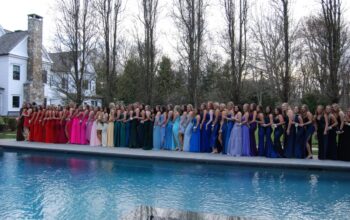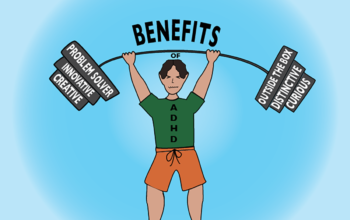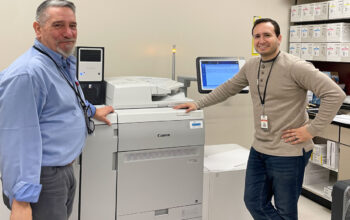Students define the feminist through action and equality
Julie Song, Editor-in-Chief
@juliescourant
The difference between “Are you a feminist?” and “Do you support women’s rights and equality?” often comes down to the fear of being labeled. These two questions are fundamentally the same, yet evidently, the label feminist distracts many from its simple belief of gender equality, autonomy and independence for all.
Seniors Amelie L’henaff, co-founder of the Gender Equality Club, and Brandon Heagle, one of the select male members of the club, are not afraid to call themselves feminists.
Their dedication to the cause begins with their definitions of feminism. “It is actively promoting women’s rights and supporting, but advocating as well,” Brandon said. “It is important, just as a person, that we make sure to secure equality for others because a lot of people don’t consider the drawbacks that women face in society.”
“My definition of feminism would be the active supporting of women’s ability to be autonomous, make their own decisions, and not have anyone make those decisions for them,” Amelie said.
While Amelie and Brandon share many key beliefs about feminism, their paths to those beliefs differ.
Amelie, as with many other young feminists, was influenced by her family. “I was raised in a very feminist household,” Amelie said. “My mom started taking my sister and I to the women’s marches in DC and in New York City when I was eleven or twelve years old.”
Such an environment fosters and promotes certain beliefs about ambition and autonomy. “My parents have always made a point of ensuring that my sister and I were taught that we should never take a backseat to leadership positions,” Amelie said. “We were always told that we should never let a man or anyone tell us what we can or cannot do with our bodies.”
In essence, Amelie’s childhood teachings surrounded this belief: “I am a human being, and not an object to be molded by other people in our lives.”
Brandon found feminism independently. “No one was really pushing me, rather I think I was guided to [feminism]because it’s the right thing to do.”
For him, feminism was a natural and logical movement. “I think we naturally find social issues we care about and I feel that [feminism]is a basic one that everyone should value.”
In both Amelie and Brandon’s stories to feminism, they present differing pipelines to feminism that adolescents may explore, through family, friends, or alone. Yet, there are roadblocks preventing many from calling themselves feminists.
Brandon said that feminism has a bad reputation and is misconstrued. “People think [feminists]are really radical or they hate men,” he said.
Amelie added that other misconceptions include demonization of the feminist. “Calling feminists Femi-Nazis, or that women want more rights than men,” Amelie said. “[Feminists are] portrayed as monsters, bad people, wanting things that are just not feasible when they don’t. They just want equality.”
To call oneself a feminist is then, not just a question of whether one supports gender equality, but also a willingness to look past the label to the core beliefs.
“If you look at what feminism is and the things that it advocates for, freedom and choice, I think there are so many people, in this high school, that agree and are feminists,” Amelie said.
Curriculum provides a comprehensive and diverse coverage of women’s history and issues
Aleena Nasruddin, Editor-in-Chief
@aleenacourant
The definition of a woman in society is expanding, and so are the methods of which the classroom approaches women’s history and contemporary issues.
Social studies teacher Jonathan Schwartz explores gender norms in various cultures in his Cultural Anthropology class. “Anthropology gives students a chance to step back and find that there are a lot of cultures in the world in which the idea of caregiving or maternal instinct does not exist,” he said. “There are a lot of opportunities for students in anthropology class to challenge the notion that being either male or female will always result in similar careers or expectations.”
Cultural anthropology emphasizes that biology determines nothing, and therefore encourages students to challenge gender norms. “I do think students walk out of that class a lot more willing to challenge the notion that just because you were born biologically male or biologically female doesn’t mean that there’s a particular path you must then follow,” Dr. Schwartz said. “No one in our culture seems to question that daycare centers are primarily run by women and that in the teaching profession, the earlier the age of the student, the more likely to be female teachers.”
While cultural anthropology class focuses on gender norms, the ultimate goal is to encourage thoughtfulness when thinking about gender in and outside the classroom. “I don’t see the goal being to create feminists,” Dr. Schwartz said. “The idea here is to take a step back and be able to look at the things that we presume are just natural in our culture.”
In the World Language department, students are taught about the role of women in Hispanic societies and key historical women figures in Spanish classes at levels three and four. “We learn about key historical figures like Malinche and contemporary figures like Sonia Sotomayor to appreciate their role and their importance,” Spanish teacher Lisa Arbues said. “I think that having a true understanding of women’s contributions inspires girls and boys.”
Dr. Arbues said that teaching about women’s history and women’s roles in society today can be impactful to students. “What we learn here is real,” she said. “I really think that students take away the idea of having a complete appreciation of the world because we learn about different perspectives.”
Spanish teacher Xiomara Brea believes that International Women’s Day and International Women’s History Month is an opportunity to recognize women’s contributions. “No one knows about the contribution of women in the Mexican Revolution. We’ve learned about Pancho Villa and Zapata, but you never hear a woman’s name even though they had such a big impact on the Mexican Revolution,” she said. “I think that a month dedicated to women’s history reminds us of everything we have accomplished so far. And perhaps a reminder that we must continue.”
Dr. Arbues agrees that women’s impact in history is often overlooked. “People often think that we are being forced to recognize women. But it’s not true. There were important female figures in history, and you have to be reminded, so that you go look and see them,” she said. “We have examples of women who wrote under men’s pen names or women who wrote and published under their husband because their books wouldn’t have been published or read otherwise.”
Similarly to the Spanish department, the Social Studies department teaches women’s history and occasionally touches upon contemporary women’s issues in class with socratic seminars in American Studies or simulations in AP United States History class on women’s rights. “It’s a no-brainer that we should be looking at history through as many lenses as we can,” Social Studies Department Chair Robert Stevenson said. “We should be including as many voices as we can in the curriculum.”
Looking into the future, Mr. Stevenson and the department are having an ongoing discussion about implementing new courses or changing curriculum. “I view the curriculum as a fairly organic thing,” he said. “While we have things written down with standards and goals and essential questions that I would defend, we are constantly thinking about what are the best ways to teach these standards goals and essential questions.”
Mr. Stevenson, however, mentioned that adding more classes to teach women’s history and women’s issues at the high school could result in eliminating other social studies elective courses in order to avoid hiring new staff. “The answer in education too often is more. But the reality is that it forces you to cut other courses. When we add, what do we lose?”
Dr. Schwartz believes it would be beneficial for all high schools to spend time addressing cultural distinctions. “It shouldn’t take until college for students to be able to find an opportunity to investigate deeply and seriously the importance of gender and sex,” he said. “It seems like in most of the high schools that I’m aware of, gender and sex is seen as something that you want to be careful in how you approach. I would say we have to be less careful. Not only in our school, but most schools need to be more willing to talk about gender and sex.”
Female leaders in New Canaan reflect on International Women’s Day
Aleena Nasruddin, Editor-in-Chief
@aleenacourant
The presence of female empowerment in New Canaan is rapidly growing as a result of female leaders in town. Founder of LiveGirl Sheri West empowers females by offering resources to increase gender parity in business, and co-curator of the Women of Waveny exhibit Micaela Porta increases visibility of women’s work through art exhibitions.
Ms. West decided to start the non-profit organization after experiencing obstacles based on her gender in the corporate world, as well as noticing disparities between the opportunities available to her sons versus her daughter. “In 2014, I sat down with my family and literally had a family meeting,” she said. “Everyone agreed that we wanted to create LiveGirl to pay it forward for the next generation of diverse, fierce, female leaders.”
LiveGirl offers programs free of charge to promote leadership skills, confidence, and career-readiness for girls starting in fifth grade until college.
The organization currently offers a mentoring program called SheCares that matches girls with a professional mentor to offer mental health and career support. “We’re about giving girls the skills, mentors, role models and access they need to thrive in leadership positions,” Ms. West said. “Ultimately, our goal is to close the female leadership gap.”
Ms. West sees International Women’s Day as an opportunity to shine a spotlight on women’s issues. “Right now, there are more Fortune 500 CEOs named John than women CEOs, and the gender gap has actually widened since the pandemic. Now it is estimated to take us 135 years to achieve gender parity,” she said. “International Women’s Day is an opportunity to focus on this issue and call for action, so that all women everywhere and our allies are taking the steps necessary to achieve equality.”
Likewise, Ms. Porta believes International Women’s Day and Women’s History Month is an opportunity to recognize women. However, she also believes that society should reach a point where the norm is to recognize women to begin with. “When I think of women’s history, I think of the day when we don’t need to celebrate this anymore,” Ms. Porta said. “When Ruth Bader Ginsburg was asked how many women would be enough on the Supreme Court, she said when all judges are women and nobody notices. I think that’s when we’ve made it and crossed the finish line.”
Ms. Porta was inspired to highlight women’s work in the Women in Waveny art exhibit after noticing that women’s work was often hidden in plain sight. “When the fountain at Waveny was being reinstalled, my friend Arianne Kolb and I noticed a signature saying ‘Everly’ on it. My friend started digging and realized it was Antonia Everly, who is one of the more important early 20th-century American sculptors,” she said. “She started digging further and noticed that the pictures of Waveny after the gardens and the estates were done were taken by Frances Benjamin Johnston, one of the more important early American documentary photographers. How did we not know that these two powerhouse artists had worked on Waveny?”
The concept for the show grew after Ms. Porta and Arianne Kolb were initially told by a male historian that the work of female artists on Waveny was ordinary for that time and place. “We started to think to what extent what he said was true,” Ms. Porta said. “We realized that women have always worked and worked well. They worked with intelligence, competence, and joy whether they had permission or not, whether they were doing it for themselves or not, whether they were recognized or not. What we felt in that moment was the same erasure and diminution that women have felt for years.”
According to Ms. Porta, art can help the feminist movement by acting as a device to convey meaning. “Whatever the medium, art by women or about women, even art in which women have been totally absent, tells a story,” she said. “Looking at their work, learning about its context, tells us what it was like to be a woman then, and helps us reflect on what it means for us today.
Ms. Porta believes that ultimately the main goal of feminism is to enable the fullest range of power for girls and women. “I really do think feminism is for everybody,” she said. “We just need society’s full participation in acknowledging, respecting, valuing, and empowering girls and women.”




